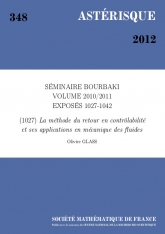Exposé Bourbaki 1027 : La méthode du retour en contrôlabilité et ses applications en mécanique des fluides d'après Coron et al.
Exposé Bourbaki 1027 : The return method in controllability and applications to fluid mechanics according to Coron et al.

- Consulter un extrait
- Année : 2012
- Tome : 348
- Format : Électronique
- Langue de l'ouvrage :
Français - Class. Math. : 93C20, 35Q30, 35Q31
- Pages : 1-16
Un système de contrôle est une équation d'évolution dépendant d'un paramètre. La théorie du contrôle cherche à déterminer comment l'on peut choisir ce paramètre en fonction du temps afin de modifier la dynamique dans un sens prescrit. Le problème de contrôlabilité s'intéresse en particulier à la possibilité de faire passer l'état du système d'un point de départ à une cible prescrite, celui de stabilisation à la possibilité de rendre un point d'équilibre stable. Dans le cas d'équations non linéaires, l'approche usuelle pour obtenir ce type de propriété est de linéariser le système, puis d'obtenir un résultat sur le linéarisé par des méthodes classiques. Cependant dans de nombreux systèmes d'origine physique, le linéarisé n'est pas nécessairement contrôlable.
La méthode du retour introduite par J.-M. Coron permet de contourner cet obstacle. Dans cet exposé, nous nous intéresserons d'abord au problème pour lequel cette méthode a été introduite, qui concerne la stabilisation de certains systèmes de dimension finie ; puis nous illustrerons la méthode par deux exemples issus de la mécanique des fluides incompressibles~: l'un, dû à J.-M. Coron, concernant l'équation d'Euler, l'autre, dû à J.-M. Coron et S. Guerrero, concernant l'équation de Navier-Stokes

